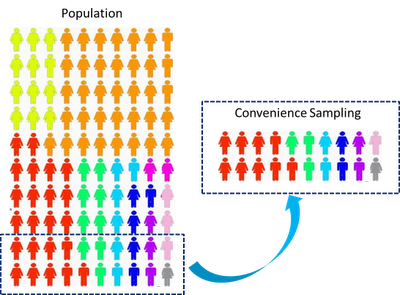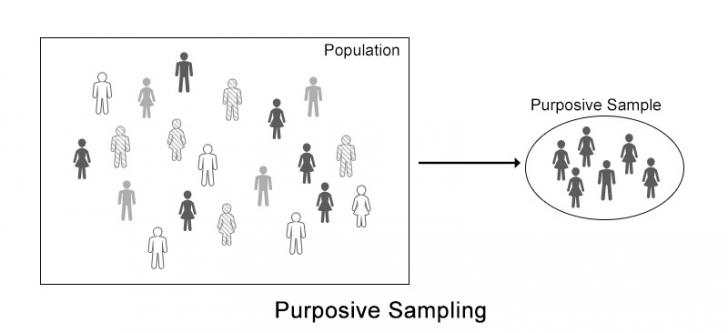Sampling Methods¶
It is almost never possible to study every person in a population to be able to get a representative overview. We can use sampling to choose a subset of the population to be able to estimate the characteristics of the wider population.
Concepts of Sampling¶
Some important definitions include:
- Target population - is the population that we wish to sample
- Sampling frame - the part of the population that is studied. This is also the portion of the population that we are capable of studying
- Sample - the part of the sampling frame that we’re actually going to study
- Sampling units - the individual members of the population that will be tested
A saturation survey is a survey that includes all units within the target population
Stages of Sampling¶
There are six distinct steps that are required in sampling
- Defining the population of interest
- Specifying the sample frame
- Specifying the sampling method
- determining the sample size
- implementing the sampling plan
- undertaking the sampling and data collection
Principles of Sampling¶
Are an important set of rules to ensure that the sampling is valid
- Sample units must be chosen in a systematic and unbiased manner
- Sample units must be easily identifiable and clearly defined
- Sample units must be independent of each other, uniform and of the same size, and should appear only once in the population
- Sample units are not interchangeable. The same units should be used throughout the extent of the study
- Once selected, units must not be discarded
- The selection process should be based on sound criteria and should avoid errors, bias and distortions
Smapling Bias¶
Does not necessarily refer to human prejudice. It is a systematic error in the sampling procedure, where the source of error is known. This will always result in a systematic skewing of the results.
Sample Size¶
The sample size depends on a number of criteria and can be determined by statistical or non-statistical means:
- The degree of precision and accuracy required
- The size of the population
- Population \(<1000\) requires up to \(30\%\)
- Population \(10,000-100,000\) requires \(10\%\)
- Population \(>150,000\) requires up to \(1\%\)
- The degree of variability or diversity within the population
The sample size may be dynamically adjusted throughout the study, though it will typically be smaller in non-probability methods than probability methods, as more of the population of interest will be included in the sample.
Sampling Methods¶
Probability sampling¶
Based on the principle that every has an equal chance of being sampled. It is random and statistical methods can be applied to ascertain how representative the sample actually is. Based on probability sampling, inferences can be made about the greater population
Simple Random Sampling ¶
- Each element must have an equal and non-zero chance of being selected
- It is the simplest and least expensive method of sampling, and completely removes bias from the sample
- It may not be truly representative of the population
Systematic/Interval Random Sampling ¶
- Is similar to simple random sampling, however after the first unit is selected, there is a periodicity to the selection.
- This may be particularly useful when the data itself is periodic
- E.g. “We sample every 3rd person”
Stratified Random Sampling ¶
- The target population is divided into a number of specific strata (distinct categories) and a certain amount of units are selected form each
- The resulting subsample makes up the final sample of the study
- It ensures that all groups, including minorities are represented within the final sample
Cluster/Multi-Stage Sampling ¶
- Similar to stratified sampling, however the clusters are typically based on a common identity
- E.g. schools, sports teams, small businesses, hospitals
Non-Probability Sampling¶
Non probability sampling takes chance out of sample selection, by making assumptions about the population of interest. Unfortunately, this means that an estimation of sampling error is not possible and it increases the risk of exclusion bias.
This also means that the results form the sample cannot be extrapolated to a larger population, although it can often be vital if the target population is not going to be well represented within the greater population.
Convenience Sampling¶
- Also called ‘accidental sampling’, as no system is put in place
- Those who are tested are convenient to the researcher
- Has an incredibly high risk of sample bias
Purposive Sampling¶
- Also known as ‘judgement sampling’
- Is commonly used when the target population is a minority, such as people with a particular medical condition, or a particular career path
- The choice of units is guided by the judgement of the researcher
Quota Sampling¶
- Quota sampling follows a specific procedure:
- Identify the characteristics of the population to be represented in the sample (e.g. men/women)
- Determine the distribution of those characteristics in the population (e.g. 75%/25%)
- Select the sample base don meeting that particular quota
- characterisations are typically demographic of SES based, such as gender, race, age, sexual preference
Snowball Sampling ¶
-
Is a method used to find units that may be difficult to come across (e.g. social elite)
- The researcher chooses a few respondents using other methods of sampling
- The respondent is then asked to refer other people on for the study who would meet the criteria and be willing to participate
- The new respondents participate and refer more people on, continuing the process
Theoretical Sampling¶
When a solid understanding of the target population is not known, or when the target population is incredibly complex, it may be necessary to start with an individual respondent and start to build a theoretical model from there.
E.g. It is unknown what may be required in respondent 3, until respondent 2 has been studied




